
Chemistry NCERT Exemplar Solutions Class 11th Chapter Six Thermodynamics - Students who are in CBSE class 11 or preparing for the competitive exams, such as JEE, NEET, WBJEE and more, can use the Thermodynamics Class 11 NCERT Exemplar for the preparation. Class 11 NCERT exemplar consists of questions and answers along with additional brainstorming questions prepared by the subject experts at Shiksha. NCERT Class 11 Thermodynamics Questions and Answers comprises multiple choice questions (MCQS), short answer questions, long questions, and matching type questions. Students can find the link for Chapter 6 Class 11 Chemistry Exemplar PDF download in this article.
Also Read: Class 11 Chemistry Chapter 6 NCERT Solutions
Thermodynamics is an important topic in both Chemistry and Physics. Currently, class 11 Chemistry chapter 5 is Thermodynamics, earlier it was chapter 6. In this chapter, students are taught about heat and work, First Law of Thermodynamics, Gibbs Free Energy, Entropy, Enthalpy and Internal Energy, Thermodynamic Equilibrium, Spontaneity and Gibbs Free Energy and more.
While studying, students must prepare the Thermodynamics Class 11 Short Notes and Solutions for quick revision. Moreover, solving the class 11 Chemistry chapter 6 exercise solutions will ensure that the student has a basic understanding of the basic concepts. Additionally, attempting the Class 11 Chemistry Chapter Six NCERT solutions will help with the textbook exercises.
Related Articles:
- Chapters List
- Download PDF of NCERT Exemplar Class 11 Chemistry Chapter Six Thermodynamics PDF
- NCERT Exemplar Solutions for Class 11 Chemistry Chapter Six Thermodynamics
- Common Mistakes and Tips for NCERT Chemistry Exemplar Chapter Six
- Important Formula Related to Chemistry Chapter Six NCERT Exemplar
- Thermodynamics Questions and Answers
Chapters List
Download PDF of NCERT Exemplar Class 11 Chemistry Chapter Six Thermodynamics PDF
Students who are looking for the Class 11 Chemistry Thermodynamics Solutions PDF can download them here. Class 11 Thermodynamics NCERT exemplar PDF is useful to prepare for the exam. Students must attempt the Class 11 Chemistry exemplar solutions only after having completed the entire chapter. Directly solving the question and answer will create confusion. NCERT Chemistry Exemplar Class 11 Chapter 6 pdf download link will be activated below.
NCERT Exemplar Solutions for Class 11 Chemistry Chapter Six Thermodynamics
Students preparing for the boards and entrance examination can practice the NCERT Exemplar Solutions Class 11th Chapter six. As we know, the NCERT Exemplar Solutions for Class 11 Thermodynamics comprises various questions based on textbook exercises and previous year questions, which are beneficial in self-assessment and preparation for the examinations. Chapter 6 Class 11 Chemistry Exemplar solutions explanation is provided below.
Common Mistakes and Tips for NCERT Chemistry Exemplar Chapter Six
Below are some common mistakes and tips related to Chemistry NCERT Exemplar Solutions Class 11 Chapter 6.
| Common Mistakes |
Tips |
| Not remembering the formula |
Make a flashcard for the formula for quick revision |
| Students usually forget the sign convention |
Write a summary of the sign convention and go through it daily |
| Many students are unable to understand the concept, so they prefer to mug up |
Students must focus on concepts and applications for a better understanding of topics |
| Directly solving the exemplar without clearing the concept |
Students must complete the chapter and exercises mentioned in it before jumping to the exemplar's questions. |
Important Formula Related to Chemistry Chapter Six NCERT Exemplar
Some of the important formulas that students must take notes on before attempting the NCERT Class 11 Thermodynamics questions and answers.
-
First Law of Thermodynamics:
-
Work Done in Isothermal Expansion (Ideal Gas):
-
Work Done in Adiabatic Process:
where (heat capacity ratio)
-
Relation Between and :
For an ideal gas,
-
Entropy Change ( ) Formula:
-
Gibbs Free Energy Equation:
-
Spontaneity Conditions:
- → Spontaneous process
- → Non-spontaneous process
- → Equilibrium
Thermodynamics Questions and Answers
| 1. Derive the relationship between ∆H and ∆U for an ideal gas. Explain each term involved in the equation |
| Ans: We know that the change in internal energy equals the heat absorbed at constant volume, i.e., U= qV.m. However, the majority of chemical reactions are carried out in flasks or test tubes under constant atmospheric pressure U= qp -PV under constant pressure, where qp is the heat absorbed by the system and -PV is the expansion work done by the system. Let's call the beginning state with subscript 1 and the end state with subscript 2. The above equation can be rewritten as U2-U1= P(V2-V1) On rearranging, we get qp= (U2+pV2) - (U1 + pV1)...........(1) Now, we can define another thermodynamic function, the enthalpy H [Greek word enthalpien, to warm or heat content] as: H = U + pV………(2) So, equation (1) becomes qp = H2- H1 = ΔH Despite the fact that q is a path dependent function, H is a state function because it is reliant on state functions U, p, and V. As a result, H is path-independent. As a result, qp is path-independent. Equation (2) can be written as for finite changes at constant pressure. ΔH= ΔU + ΔpV Since, P is constant, we can write: ΔH = ΔU + PΔV……………(3) It's worth noting that we're actually measuring changes in the enthalpy when heat is absorbed by the system at constant pressure. Remember ΔH= qp , heat absorbed by the system at constant pressure. H is negative for exothermic reactions, which produce heat, and positive for endothermic reactions, which absorb heat from the environment. As a result, equation (3) becomes U = qv at constant volume (V=0). ΔH= ΔU=qv Let's have a look at a gaseous reaction. If VA is the total volume of gaseous reactants, VB is the total volume of gaseous products, nA is the number of moles of gaseous reactants, and nB is the number of moles of gaseous products, then we write using the ideal gas law., PVA = nART PVB = nBRT Thus, PVB- PVA = nBRT - nART = (nB-nA)RT Or, P(VB- VA) = (nB - nA)RT Or, pΔV = ΔngRT……….(4) The number of moles of gaseous products minus the number of moles of gaseous reactants is denoted by ng. Equation (3) is obtained by substituting the value of PV from equation (4) in equation (3). ΔH = ΔU + ΔngRT…………(5) |
| 2. Extensive properties depend on the quantity of matter but intensive properties do not. Explain whether the following properties are extensive or intensive. Mass, internal energy, pressure, heat capacity, molar heat capacity, density, mole fraction, specific heat, temperature and molarity. |
| Ans: A contrast is drawn in thermodynamics between extensive and intense qualities. An extensive property is one whose value is proportional to the amount or size of matter in the system. Extensive properties include mass, volume, internal energy, enthalpy, and heat capacity, to name a few. Properties that are independent of the amount or size of matter present are known. As though they were intensive properties Temperature, density, and pressure, for example, are intense properties. A molar property, 𝝌m, is the value of an extensive property of the system for 1 mol of the substance. If n is the amount of matter, 𝝌m = 𝝌/n, is independent of the amount of matter. An intensive property is always the ratio of two extensive properties. Extensive/Extensive = Intensive E.g., Mole Fraction = Moles / Total number of moles = Extensive/Extensive |
| 60. |
| Ans: The enthalpy change that occurs when one mole of an ionic compound dissociates into its ions in a gaseous state is called the lattice enthalpy of an ionic compound. Na+ + Cl- (s) → Na+ (g) + Cl- (g) Δlattice H0 → +788 KJmol-1 Let us now calculate the lattice enthalpy of Na+Cl- (s) by following steps given below: |
| 3. ΔG is net energy available to do useful work and is thus a measure of “free energy”. Show mathematically that ΔG is a measure of free energy. Find the unit of ΔG. If a reaction has positive enthalpy change and positive entropy change, under what condition will the reaction be spontaneous? |
| Ans: We know, ΔStotal = ΔSsys + ΔSsurr When a system is in thermal equilibrium with its surroundings, the surroundings' temperature is the same as the system's. Furthermore, a rise in the enthalpy of the surroundings equals a decrease in the system's enthalpy. As a result of the entropy shift in the environment, ΔSsurr = ΔHsurr/T = -ΔHsys/T ΔStotal = ΔSsys = (-ΔHsys/T) Rearranging the above equation: ΔStotal = TΔSsys - ΔHsys For spontaneous process, ΔStotal > 0, so TΔSsys - ΔHsys> 0 ⇒ ( - ΔHsys - TΔSsys) > 0 The above equation can be written as - ΔG > 0 ΔG = ΔH - TΔS < 0 ΔHsys is the enthalpy change of a reaction, TΔSsys is the energy which is not available to do useful work. As a result, G is a measure of 'free energy,' as it is the net energy available to conduct beneficial work. As a result, it's also known as the reaction's free energy. At constant pressure and temperature, G gives a set of conditions for spontaneity, (i) If ΔG is negative (<0), the process is spontaneous. (ii) If ΔG is positive (>0), the process is nonspontaneous. Unit of ΔG is Joule. The reaction will be spontaneous at high temperature.
|
| 4. Graphically show the total work done in an expansion when the state of an ideal gas is changed reversibly and isothermally from (Pi, Vi) to (Pf, Vf) . With the help of a pV plot compare the work done in the above case with that carried out against a constant external pressure Pf.
|
| Ans: (i) Reversible work is represented by the combined areas
|
Commonly asked questions
Extensive properties depend on the quantity of matter but intensive properties do not. Explain whether the following properties are extensive or intensive. Mass, internal energy, pressure, heat capacity, molar heat capacity, density, mole fraction, specific heat, temperature and molarity.
This is a Long Answer Type Questions as classified in NCERT Exemplar
A contrast is drawn in thermodynamics between extensive and intense qualities. An extensive property is one whose value is proportional to the amount or size of matter in the system. Extensive properties include mass, volume, internal energy, enthalpy, and heat capacity, to name a few.
Properties that are independent of the amount or size of matter present are known.
As though they were intensive properties Temperature, density, and pressure, for example, are intense properties. A molar property? m, is the value of an extensive property of the system for 1 mol of the substance. If n is the amount of matter? m =? /n, is independent of the amount of matter. An intensive property is always the ratio of two extensive properties.
Extensive/Extensive = Intensive
E.g., Mole Fraction = Moles / Total number of moles = Extensive/Extensive
ΔG is net energy available to do useful work and is thus a measure of “free energy”. Show mathematically that ΔG is a measure of free energy. Find the unit of ΔG. If a reaction has positive enthalpy change and positive entropy change, under what condition will the reaction be spontaneous?
This is a Long Answer Type Questions as classified in NCERT Exemplar
We know,
ΔStotal = ΔSsys + ΔSsurr
When a system is in thermal equilibrium with its surroundings, the surroundings' temperature is the same as the system's. Furthermore, a rise in the enthalpy of the surroundings equals a decrease in the system's enthalpy. As a result of the entropy shift in the environment,
ΔSsurr = ΔHsurr/T = -ΔHsys/T
ΔStotal = ΔSsys = (-ΔHsys/T)
Rearranging the above equation:
ΔStotal = TΔSsys - ΔHsys
For spontaneous process,
ΔStotal > 0, so
TΔSsys - ΔHsys> 0
⇒ ( - ΔHsys - TΔSsys) > 0
The above equation can be written as
- ΔG > 0
ΔG = ΔH - TΔS < 0
ΔHsys is the enthalpy change of a reaction, TΔSsys is the energy which is not available to do
useful work. As a result, G is a measure of 'free energy, ' as it is the net energy available to conduct beneficial work. As a result, it's also known as the reaction's free energy. At constant pressure and temperature, G gives a set of conditions for spontaneity,
(i) If ΔG is negative (<0), the process is spontaneous.
(ii) If ΔG is positive (>0), the process is nonspontaneous.
Unit of ΔG is Joule.
The reaction will be spontaneous at high temperature.
Graphically show the total work done in an expansion when the state of an ideal gas is changed reversibly and isothermally from (Pi, Vi) to (Pf, Vf) . With the help of a pV plot compare the work done in the above case with that carried out against a constant external pressure Pf.
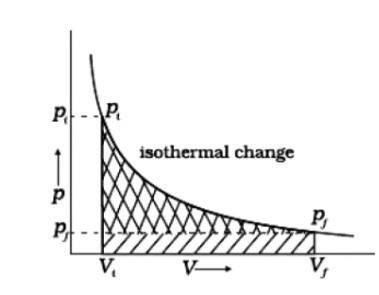
(i) Reversible work is represented by the combined areas
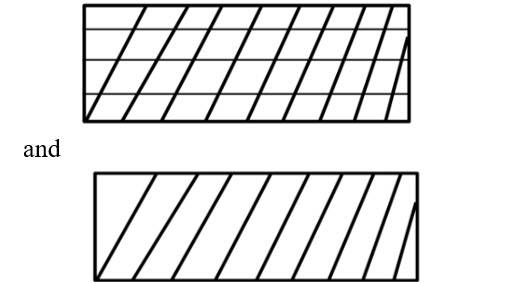
(ii) Work against constant pressure, Pf is represented by the area
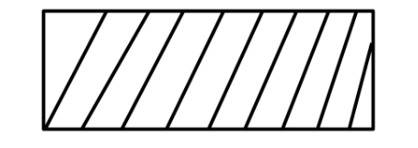
Work (i) > Work (ii).
The Approach While Dealing With the Concept of Thermodynamics
Since the concept of Thermodynamics and the terminologies of Chemistry are a bit new to the students, they should first learn the names of different chemical components and how to write the chemical equations properly through NCERT Exemplars and Solutions books.While writing the chemical equations, they might make some mistakes. To avoid making errors, they should practice writing the equations at home.
Solving previous years' question papers will help them to manage time and quickly analyze the answers in their minds.
Comparing their own answers with the solutions provided in the NCERT Exemplar Solutions will help them to be sure of the fact that how efficient they are at answering the questions of Chemistry. It will help them to boost their confidence as well.
Revising is extremely important when it comes to answering Chemistry questions since a lack of practice and habits of writing can make the students forget some important information that they should include in their answers. The mock papers are beneficial for them to serve this purpose
Rational thinking plays an important part in answering the questions in Chemistry. The students need to have a clear idea of the basic physical characteristics of different chemical compounds and how they will react depending on the presence of other external factors. Practicing is the only way to sharpen their thinking ability and analysis power.
18.0 g of water completely vapourises at 100°C and 1 bar pressure and the enthalpy change in the process is 40.79 kJ/ mol. What will be the enthalpy change for vapourising two moles of water under the same conditions? What is the standard enthalphy of vapourisation for water?
This is a Short Answer Type Questions as classified in NCERT Exemplar
Enthalpy of a reaction is the energy change per mole for the process.
18 g of H2O = 1 mole ΔHvap = 40.79 kJ/ mol
Enthalpy change for vapourising 2 moles of H2O = 2 x 40.79 = 81.58 kJ ΔH°vap = 40.79 kJ mol-1.
One mole of acetone requires less heat to vapourise than 1 mol of water. Which of the two liquids has higher enthalpy of vapourisation?
This is a Short Answer Type Questions as classified in NCERT Exemplar
Due to weak force of attraction between molecules, acetone requires less heat to vaporise. Hence, water has higher enthalpy of vaporization.
Standard molar enthalpy of formation, ∆fHᶱ is just a special case of enthalpy of reaction, ∆r HV . Is the ∆r HV for the following reaction same as ∆f HV ? Give reason for your answer.
CaO(s) + CO2(g) → CaCO3(s); ∆fHᶱ = –178.3 kJ /mol
This is a Short Answer Type Questions as classified in NCERT Exemplar
Standard molar enthalpy of formation, rH1- is just a special case of fH2-, where
one mole of a compound is formed from its constituent elements. In the above equation, enthalpy of formation and enthalpy of reaction is not the same.
The value of ∆fHᶱ for NH3 is – 91.8 kJ/ mol. Calculate enthalpy change for the following reaction :
2NH3(g) → N2(g) + 3H2(g)
This is a Short Answer Type Questions as classified in NCERT Exemplar
ΔH for formation is given. For the reverse reaction, ΔHchanges sign as the reverse of exothermic reaction will be endothermic. So, ΔH for decomposition is - (-91.8)=91.8 for one mole. But here, two moles are decomposing,
ΔH=2×91.8=183.6KJ
Enthalpy is an extensive property. In general, if enthalpy of an overall reaction A→B along one route is ∆r H and ∆r H1, ∆rH2, ∆rH3 ..... represent enthalpies of intermediate reactions leading to product B. What will be the relation between ∆r H for overall reaction and ∆rH1 , ∆rH2 ..... etc. for intermediate reactions.
This is a Short Answer Type Questions as classified in NCERT Exemplar
According to Hess’s law, ΔrH = ΔrH1+ ΔrH2+ΔrH3
This is so because during the reaction A→ B, B’s formation undergoes various intermediate reactions, with the overall value of the enthalpy being ΔrH.
The enthalpy of atomisation for the reaction CH4(g)→ C(g) + 4H(g) is 1665 kJ/ mol. What is the bond energy of C–H bond?
This is a Short Answer Type Questions as classified in NCERT Exemplar
The reaction presented in the question is
CH4 (g)→C (g) + 4H (g)
Now, ΔaH = 1665 kJ/mol
The mean bond enthalpy of the C-H bond should be used here. For the atomisation of 4 moles of C-H bonds, the value is 1665 kJ/mol. So, per mole energy = 1665/4 = 416.2 kJ / mol
Use the following data to calculate ∆lattice Hᶱ for NaBr. ∆sub Hᶱ for sodium metal = 108.4 kJ/ mol
Ionization enthalpy of sodium = 496 kJ/mol
Electron gain enthalpy of bromine = – 325 kJ mol–1 Bond dissociation enthalpy of bromine = 192 kJ mol–1 ∆f Hᶱ for NaBr (s) = – 360.1 kJ/ mol
This is a Short Answer Type Questions as classified in NCERT Exemplar
In order to calculate the lattice enthalpy of NaBr,
(i) Na (s) →Na (g) ; ΔsubH? =108.4 kJ/mol
(ii) Na→Na+ + e- ΔiH? = 496kJ/ mol
(iii) Br→ Br, Δdiss H? = 96kJ/ mol
(iv) Br+e-Br- ΔegH? = - 325 kJmol-1
? fH? =? subH? + Δdiss H + Δi H? + Δi H? + Δeg H? +? lattice H?
= -360.1 -108.4-96-496+325 = -735.5KJ/ mol
Given that ∆H= 0 for mixing of two gases. Explain whether the diffusion of these gases into each other in a closed container is a spontaneous process or not?
This is a Short Answer Type Questions as classified in NCERT Exemplar
It is a spontaneous process. Although enthalpy change is zero, randomness or disorder (ΔS) increases and ΔS is positive. Therefore, in the equation, ΔG = ΔH – TΔS, the term TΔS will be negative. Hence ΔG will be negative.
Heat has randomising influence on a system and temperature is the measure of average chaotic motion of particles in the system. Write the mathematical relation which relates these three parameters.
This is a Short Answer Type Questions as classified in NCERT Exemplar
Heat has a randomising influence on a system and temperature is the measure of average chaotic motion of particles in the system. The mathematical relation which relates these three parameters is? S = qrev/ T
Here? S = change in entropy ^
qrcv = heat of reversible reaction '
T = temperature
Increase in enthalpy of the surroundings is equal to decrease in enthalpy of the system. Will the temperature of system and surroundings be the same when they are in thermal equilibrium?
This is a Short Answer Type Questions as classified in NCERT Exemplar
Yes, when the system and the surroundings are in thermal equilibrium, their temperatures are the same.
At 298 K. Kp for the reaction N2O4 (g) 2NO2 (g) is 0.98. Predict whether the reaction is spontaneous or not.
This is a Short Answer Type Questions as classified in NCERT Exemplar
ΔrG° = -RT ln Kp
= -RT ln (0.98)
Since In (0.98) is negative
.’. ΔrG° is positive the reaction is non spontaneous
A sample of 1.0 mol of a monoatomic ideal gas is taken through a cyclic process of expansion and compression as shown in Fig. 6.1. What will be the value of ?H for the cycle as a whole?
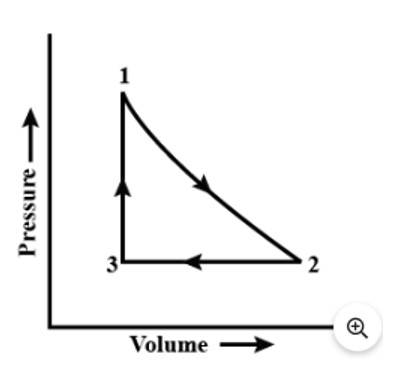
This is a Short Answer Type Questions as classified in NCERT Exemplar
During cyclic process, change in internal energy is zero.
ΔU = 0
and no work is said to be done, as system returns to the initial state.
For a steady state cyclic process at any given stage enthalpy is one single value however, at different stage it would vary.
ΔH = 0
The standard molar entropy of H2O (l) is 70 J K–1 mol–1. Will the standard molar entropy of H2O(s) be more, or less than 70 J K–1 mol–1?
This is a Short Answer Type Questions as classified in NCERT Exemplar
The standard molar entropy of H20 (1) is 70 J K-1 mol-1. The solid form of H20 is ice. In ice, molecules of H20 are less random than in liquid water. Thus, molar entropy of H20 (s) < molar entropy of H20 (1). The standard molar entropy of H20 (s) is less than 70 J K-1 mol-1.
Identify the state functions and path functions out of the following : enthalpy, entropy, heat, temperature, work, free energy.
This is a Short Answer Type Questions as classified in NCERT Exemplar
State functions: Enthalpy, entropy, temperature, free energy Path functions: Heat, work.
The molar enthalpy of vapourisation of acetone is less than that of water. Why?
This is a Short Answer Type Questions as classified in NCERT Exemplar
Molar enthalpy of vaporization is more for water due to hydrogen bonding between water molecules.
Which quantity out of ∆rG and ∆rGᶱ will be zero at equilibrium?
This is a Short Answer Type Questions as classified in NCERT Exemplar
Gibbs energy for a reaction in which all reactants and products are in standard state. ΔrG° is related to the equilibrium constant of the reaction as follows
ΔrG = ArG° + RT In K
At equilibrium, 0 = ΔrG° + RT InA– ( {ΔrG = 0) or ΔrG° =-RT lnK
ΔrG° = 0 when K= 1
For all other values of K, ArG° will be non-zero.
Predict the change in internal energy for an isolated system at constant volume.
This is a Short Answer Type Questions as classified in NCERT Exemplar
For an isolated system w = 0, q = 0
Since ΔU= q + w = 0 + 0 = 0, ΔU= 0
Although heat is a path function but heat absorbed by the system under certain specific conditions is independent of path. What are those conditions? Explain.
This is a Short Answer Type Questions as classified in NCERT Exemplar
At constant volume
q = ΔU + (-w)
-w = pΔ q = AU + pΔV
ΔV = 0 (at constant volume)
Hence, qv = ΔU + 0 = ΔU= change in internal energy at constant pressure, qp = AU + pΔV
Since ΔU + pΔV=ΔH
=> qp = ΔH change in enthalpy
Hence, at constant volume and at constant pressure, heat change is a state function because it is equal to ΔU and ΔH respectively which are state functions.
Expansion of a gas in vacuum is called free expansion. Calculate the work done and the change in internal energy when 1 litre of ideal gas expands isothermally into vacuum until its total volume is 5 litre?
This is a Short Answer Type Questions as classified in NCERT Exemplar
During free expansion, external pressure is zero, so Work done, w = -pextΔV
= -0(5 – 1) = 0
Since the gas is expanding isothermally, therefore, q = 0
ΔU = q + w =0+0=0
Heat capacity (CP) is an extensive property but specific heat (c) is an intensive property. What will be the relation between Cp and c for 1 mol of water?
This is a Short Answer Type Questions as classified in NCERT Exemplar
For water, molar heat capacity = 18 x Specific heat or Cp = 18 x c
But, specific heat,
C = 4.18 J g-1 K-1 Heat capacity,
Cp = 18 x 4.18 JK-1 = 75.24 JK-1
The difference between Cp and Cv can be derived using the empirical relation H = U + pV. Calculate the difference between Cp and Cv for 10 moles of an ideal gas.
This is a Short Answer Type Questions as classified in NCERT Exemplar
Given that, Cv = heat capacity at constant volume,
Cp = heat capacity at constant pressure
Difference between Cp and Cv is equal to gas constant (R).
.’. Cp – Cv = nR (where, n = no. of moles)
= 10 x 8.314 = 83.14J
If the combustion of 1g of graphite produces 20.7 kJ of heat, what will be molar enthalpy change? Give the significance of sign also.
This is a Short Answer Type Questions as classified in NCERT Exemplar
Molar enthalpy change for graphite (ΔH)
= enthalpy change for 1 g x molar mass of C = -20.7×12 = -2.48 x 102 kJ mol-1
Since the sign of ΔH = -ve, it is an exothermic reaction.
The net enthalpy change of a reaction is the amount of energy required to break all the bonds in reactant molecules minus amount of energy required to form all the bonds in the product molecules. What will be the enthalpy change for the following reaction.
H2(g) + Br2(g) → 2HBr(g)
Given that Bond energy of H2, Br2 and HBr is 435 kJ/ mol, 192 kJ/ mol and 368 kJ/ mol respectively
This is a Short Answer Type Questions as classified in NCERT Exemplar
ΔrH? =ΣB.E (reactant)-ΣB.E (product)
=B.E.H2 + BEBR2 -2 ×B.E>HBr
= 435+192-2 (×368)
= 109KJmol-1
The enthalpy of vapourisation of CCl4 is 30.5 kJ/ mol. Calculate the heat required for the vapourisation of 284 g of CCl4 at constant pressure. (Molar mass of CCl4 = 154 g/mol).
This is a Short Answer Type Questions as classified in NCERT Exemplar
As per the information provided in the question, for one mole of CCl4 (154 g), the heat of vaporisation required is 30.5 kJ/mol .
Hence for the vaporisation of 284 g of CCl4, we require:
= 56.2 kJ
The enthalpy of reaction for the reaction : 2H2(g) + O2(g) → 2H2O(l) is ∆rHᶱ = – 572 kJ/ mol. What will be standard enthalpy of formation of H2O (l ) ?
Chemistry NCERT Exemplar Solutions Class 11th Chapter six
Standard molar enthalpy of formation is the enthalpy change for the formation of one mole of a compound from its most stable states or reference states. As per the given information in the question, the standard enthalpy for the given equation is – 572 kJ mol–1
Now the enthalpy of formation for H2O will be half the enthalpy of the value in the given equation. So now we can calculate that
? fH? = = -286KJ/mol
What will be the work done on an ideal gas enclosed in a cylinder, when it is compressed by a constant external pressure, pext in a single step as shown in Fig. 6.2. Explain graphically
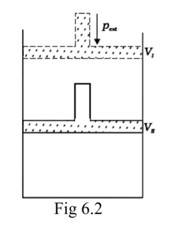
This is a Short Answer Type Questions as classified in NCERT Exemplar
Assumption: Cylinder is filled with one mole gas, and the piston is frictionless. Let the pressure of gas inside be p and the volume of gas be V_ {I}.
Piston is moved towards the inside to make the external pressure (P_ {ext}) equal to p. Now, let us assume that this change takes place in a single step, hence, V is the final volume. The work done by the piston is depicted in the graph shown below by shading the area.
PextΔV= AV1 (V1-V2)
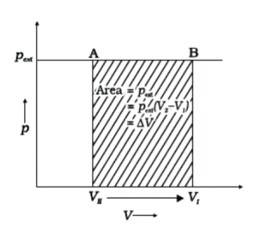
How will you calculate work done on an ideal gas in a compression, when change in pressure is carried out in infinite steps ?
This is a Short Answer Type Questions as classified in NCERT Exemplar
When a process can be reversed by bringing an extremely small change in it, we call it a reversible process. The pressure-volume graph can be used to calculate the work done. The pressure is not constant, and changes in infinitesimal amounts as compression happens from initial volume Vi to the final volume Vf. The below graph depicts the work done with the shaded area.
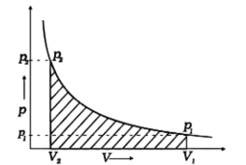
Represent the potential energy/enthalpy change in the following processes graphically.
(a) Throwing a stone from the ground to roof.
(b) 12H2(g) + 12Cl2(g) HCl(g) ?rH? = –92.32 kJ/ mol
In which of the processes potential energy/enthalpy change is contributing factor to the spontaneity?
This is a Short Answer Type Questions as classified in NCERT Exemplar
Throwing a stone from ground to roof
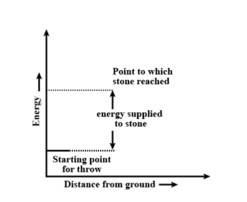
b) the reaction involved is a process where the energy decreases after the reaction. It can be represented as:In process b), potential energy/enthalpy change is a contributing factor to the spontaneity.
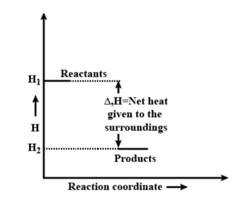
Enthalpy diagram for a particular reaction is given in Fig. 6.3. Is it possible to decide spontaneity of a reaction from given diagram. Explain
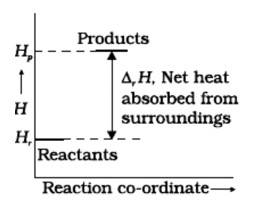
This is a Short Answer Type Questions as classified in NCERT Exemplar
No, for the state of spontaneity, the enthalpy change is not the only criteria. Entropy also needs to be taken into account here.
1.0 mol of a monoatomic ideal gas is expanded from state (1) to state (2) as shown in Fig. 6.4. Calculate the work done for the expansion of gas from state (1) to state (2) at 298 K.
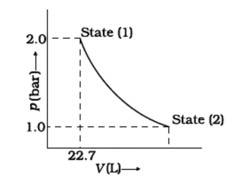
This is a Short Answer Type Questions as classified in NCERT Exemplar
We can conclude from the figure that this change is a reversible change.
Now,
W= -2.303nRT log
But, p1V1 = p2V2 = = = =2
W= -2.303nRT log
= -2.303 *8.314*1*298*log2
= -2.303 *8.314*298*0.3010J
= -1717.46J
An ideal gas is allowed to expand against a constant pressure of 2 bar from 10 L to 50 L in one step. Calculate the amount of work done by the gas. If the same expansion were carried out reversibly, will the work done be higher or lower than the earlier case?
This is a Short Answer Type Questions as classified in NCERT Exemplar
We know that the amount of work done =-pext? V
On substituting the values in the formula, we get,
-2bar* (50-10)L=-80Lbar
According to the described problem,1 LBar = 100J
Therefore, -80 L bar= (-80*100)= -8000J
= -8kJ, which is the amount of work done
The significance of the negative sign states that the work is done on the surroundings of the system. In the case of reversible expansion, the work done will be more.
Thermodynamics is not concerned about______.
(i) Energy changes involved in a chemical reaction.
(ii) The extent to which a chemical reaction proceeds.
(iii) The rate at which a reaction proceeds.
(iv) The feasibility of a chemical reaction.
This is a Multiple Choice Questions as classified in NCERT Exemplar
Thermodynamics is not concerned about how and at what rate these energy transformations are carried out but is based on initial and final states of a system undergoing the change. Laws of thermodynamics apply only when a system is in equilibrium or moves from one equilibrium state to another equilibrium state.
Which of the following statements is correct?
(i) The presence of reacting species in a covered beaker is an example of open system.
(ii) There is an exchange of energy as well as matter between the system and the surroundings in a closed system.
(iii) The presence of reactants in a closed vessel made up of copper is an example of a closed system.
(iv) The presence of reactants in a thermos flask or any other closed insulated vessel is an example of a closed system.
This is a Multiple Choice Questions as classified in NCERT Exemplar
Option (iii)
The presence of reactants in a closed vessel made of conducting material e.g., copper or steel is an example of a closed system.
The state of a gas can be described by quoting the relationship between___.
(i) Pressure, volume, temperature
(ii) Temperature, amount, pressure
(iii) Amount, volume, temperature
(iv) Pressure, volume, temperature, amount
This is a Multiple Choice Questions as classified in NCERT Exemplar
option (i)
Variables like p, V, T are called state variables or state functions because their values depend only on the state of the system and not on how it is reached.
The volume of gas is reduced to half from its original volume. The specific heat will be ______.
(i) Reduce to half
(ii) Be doubled
(iii) Remain constant
(iv) Increase four times
This is a Multiple Choice Questions as classified in NCERT Exemplar
Option (iii)
Specific heat capacity is the quantity of heat required to raise the temperature of one unit mass of a substance by one degree Celsius (or 1 Kelvin). That is why it is an intensive property which does not depend on mass.
During complete combustion of one mole of butane, 2658 kJ of heat is released. The thermochemical reaction for above change is
(i) 2C4H10(g) + 13O2(g) → 8CO2(g) + 10H2O(l) ∆c H = –2658.0 kJ/mol
(ii) C4H10(g) + O2 (g) → 4CO2 (g) + 5H2O (g) ∆c H = –1329.0 kJ/mol
(iii) C4H10(g) + O2 (g) → 4CO2 (g) + 5H2O (l) ∆c H = –2658.0 kJ/mol
(iv) C4H10 (g) + O2 (g) → 4CO2 (g) + 5H2O (l) ∆c H = +2658.0 kJ/mol
This is a Multiple Choice Questions as classified in NCERT Exemplar
option (iii)
Standard enthalpy of combustion is defined as the enthalpy change per mole (or per unit amount) of a substance when it undergoes combustion and all the reactants and products being in their standard states at the specified temperature.
∆fU of formation of CH4 (g) at certain temperature is –393 kJ/mol. The value of ∆fH is
(i) zero
(ii) < ∆f U
(iii) > ∆f U
(iv) Equal to ∆fU
This is a Multiple Choice Questions as classified in NCERT Exemplar
The correct option is B <ΔU
The balanced equation for the combustion of methane is:
CH4 (g)+2O2 (g)→CO2 (g)+2H2O (l)
Here, Δng=1−3=−2
ΔH =ΔU +ΔngRT
ΔH =−393−2RT
∴ΔH <ΔU
In an adiabatic process, no transfer of heat takes place between system and surroundings. Choose the correct option for free expansion of an ideal gas under adiabatic condition from the following.
(i) q = 0, ∆T ≠ 0, w = 0
(ii) q ≠ 0, ∆T = 0, w = 0
(iii) q = 0, ∆T = 0, w = 0
(iv) q = 0, ∆T < 0, w ≠ 0 Vf
This is a Multiple Choice Questions as classified in NCERT Exemplar
Option (iii)
In free expansion, w=0 because volume is constant, as the process is adiabatic q = 0 and from first law of thermodynamics.
U=q+w
This means that internal energy remains constant.
The pressure volume work for an ideal gas can be calculated by using the expression w = - dv. The work can also be calculated from the pV−plot by using the area under the curve within the specified limits. When an ideal gas is compressed (a) reversibly or (b) irreversibly from volume Vi to Vf. Choose the correct option.
(i) w (reversible) = w (irreversible)
(ii) w (reversible) < w (irreversible)
(iii) w (reversible) > w (irreversible)
(iv) w (reversible) = w (irreversible) + pex.?V
Kindly go through the solution
option (ii)
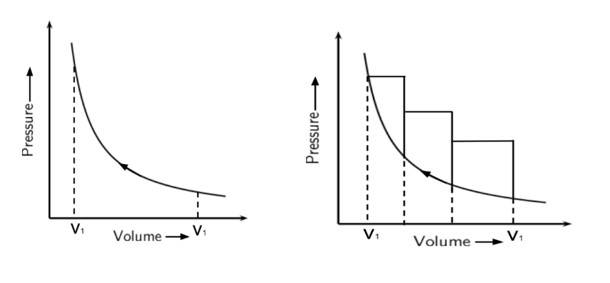
The entropy change can be calculated by using the expression ∆S = . When water freezes in a glass beaker, choose the correct statement amongst the following:
(i) ∆S (system) decreases, but ∆S (surroundings) remains the same.
(ii) ∆S (system) increases, but ∆S (surroundings) decreases.
(iii) ∆S (system) decreases, but ∆S (surroundings) increases.
(iv) ∆S (system) decreases, and ∆S (surroundings) also decreases.
This is a Multiple Choice Questions as classified in NCERT Exemplar
option (iii)? S (system) decreases, but? S (surroundings) increases.
On the basis of thermochemical equations (a), (b) and (c), find out which of the algebric relationships given in options (i) to (iv) is correct.
(a) C (graphite) + O2 (g) → CO2 (g) ; ∆rH = x kJ/ mol
(b) C (graphite) + O2 (g) → CO (g) ; ∆rH = y kJ/ mol
(c) CO (g) + O2 (g) → CO2 (g) ; ∆rH = z kJ/ mol
(i) z = x + y
(ii) x = y – z
(iii) x = y + z
(iv) y = 2z – x
This is a Multiple Choice Questions as classified in NCERT Exemplar
option (iii)
When we add equations (b) and (c) we will get equation (a); hence, the Algebraic sum of y and z will give x, x =y + z.
Consider the reactions given below. On the basis of these reactions find out which of the algebric relations given in options (i) to (iv) is correct?
(a) C (g) + 4H (g) → CH4 (g); ∆r H = x kJ/ mol
(b) C (graphite,s) + 2H2 (g) → CH4 (g); ∆rH = y kJ /mol
(i) x = y
(ii) x = 2y
(iii) x > y
(iv) x < y
This is a Multiple Choice Questions as classified in NCERT Exemplar
option (iii)
Same bonds are formed in reaction (a) and (b) but bonds between the reactant molecules are broken only in reaction (b)
The enthalpies of elements in their standard states are taken as zero. The enthalpy of formation of a compound
(i) Is always negative
(ii) Is always positive
(iii) May be positive or negative
(iv) Is never negative
This is a Multiple Choice Questions as classified in NCERT Exemplar
option (iii)
The enthalpies of elements in their standard states are taken as zero. The enthalpy of formation of a compound as the reaction could be exothermic or endothermic.
Enthalpy of sublimation of a substance is equal to
(i) Enthalpy of fusion + enthalpy of vapourisation
(ii) Enthalpy of fusion
(iii) Enthalpy of vapourisation
(iv) Twice the enthalpy of vapourisation
This is a Multiple Choice Questions as classified in NCERT Exemplar
Option (i)
Enthalpy of sublimation can be shown as
Solid | Liquid | Vapour
Hence, Enthalpy of sublimation of a substance is equal to enthalpy of fusion + enthalpy of vaporisation.
Which of the following is not correct?
(i) ∆G is zero for a reversible reaction
(ii) ∆G is positive for a spontaneous reaction
(iii) ∆G is negative for a spontaneous reaction
(iv) ∆G is positive for a non-spontaneous reaction
This is a Multiple Choice Questions as classified in NCERT Exemplar
option (ii)
positive for a spontaneous reaction
Thermodynamics mainly deals with
(i) Interrelation of various forms of energy and their transformation from one form to another.
(ii) Energy changes in the processes which depend only on initial and final states of the microscopic systems containing a few molecules.
(iii) How and at what rate these energy transformations are carried out.
(iv) The system in equilibrium state or moving from one equilibrium state to another equilibrium state.
This is a Multiple Choice Questions as classified in NCERT Exemplar
option (i)
The laws of thermodynamics deal with energy changes of macroscopic systems involving a large number of molecules rather than microscopic systems containing a few molecules. Laws of thermodynamics apply only when a system is in equilibrium or moves from one equilibrium state to another equilibrium state.
In an exothermic reaction, heat is evolved, and system loses heat to the surroundings. For such system
(i) qp will be negative
(ii) ∆rH will be negative
(iii) qp will be positive
(iv) ∆rH will be positive
This is a Multiple Choice Questions as classified in NCERT Exemplar
option (i) and (ii)
In an exothermic reaction, heat is evolved, and system loses heat to the surroundings. Therefore, qp will be negative and? rH will also be negative. Hence, option (i) and (ii) is the correct answer.
The spontaneity means, having the potential to proceed without the assistance of external agency. The processes which occur spontaneously are (i) flow of heat from colder to warmer body. (ii) Gas in a container contracting into one corner. (iii) Gas expanding to fill the available volume. (iv) Burning carbon in oxygen to give carbon dioxide.
This is a Multiple Choice Questions as classified in NCERT Exemplar
option (iii) and (iv)
Gas expands to fill the available space spontaneously, and burning of carbon to carbon dioxide is spontaneous
For an ideal gas, the work of reversible expansion under isothermal condition can be calculated by using the expression w= -nRTln
A sample containing 1.0 mol of an ideal gas is expanded isothermally and reversibly to ten times of its original volume, in two separate experiments. The expansion is carried out at 300 K and at 600 K respectively. Choose the correct option.
(i) Work done at 600 K is 20 times the work done at 300 K.
(ii) Work done at 300 K is twice the work done at 600 K.
(iii) Work done at 600 K is twice the work done at 300 K.
(iv) ∆U = 0 in both cases.
This is a Multiple Choice Questions as classified in NCERT Exemplar
option (iv)
For
isothermal reversible change
q= -w = nRTln =2.303nRTlog
= = =2
For
isothermal expansion of ideal gases, ? U = 0
Since,
temperature is constant this means there is no change in internal energy.
Consider the following reaction between zinc and oxygen and choose the correct options out of the options given below:
2Zn(s) + O2(g) → 2ZnO (s) ; ∆H = – 693.8 kJ/mol
(i) The enthalpy of two moles of ZnO is less than the total enthalpy of two moles of Zn and one mole of oxygen by 693.8 kJ.
(ii) The enthalpy of two moles of ZnO is more than the total enthalpy of two moles of Zn and one mole of oxygen by 693.8 kJ.
(iii) 8 kJ mol–1 energy is evolved in the reaction.
(iv) 8 kJ mol–1 energy is absorbed in the reaction.
This is a Multiple Choice Questions as classified in NCERT Exemplar
option (i) and (iii)

Match the following :
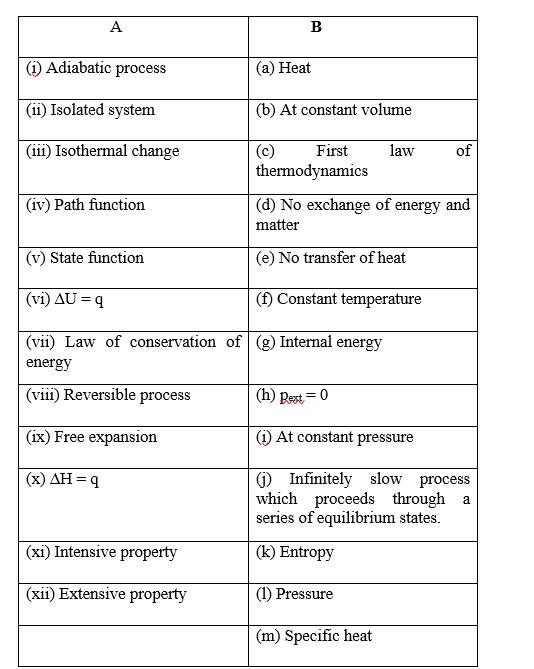
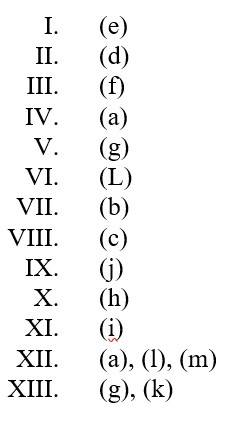
Match the following processes with entropy change:

This is a Matching Type Questions as classified in NCERT Exemplar
(i) (b)
(ii) (c)
(iii) (a)
Match the following parameters with description for spontaneity:
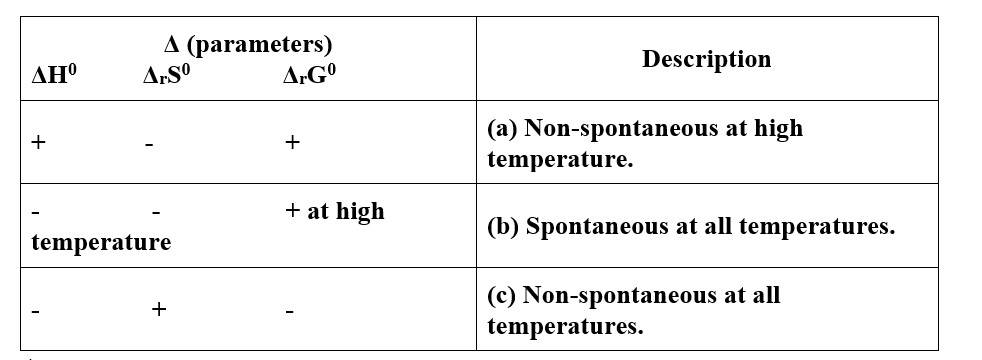
This is a Matching Type Questions as classified in NCERT Exemplar
(i)- (c)
(ii)- (a)
(iii)- (b)
Match the following:
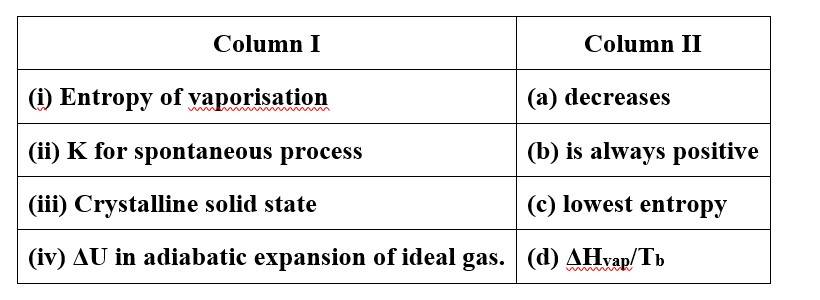
This is a Matching Type Questions as classified in NCERT Exemplar
(i)- (b), (d)
(ii)- (b)
(iii)- (c)
(iv)- (a)
Assertion (A): Combustion of all organic compounds is an exothermic reaction.
Reason (R) : The enthalpies of all elements in their standard state are zero.
(i) Both A and R are true and R is the correct explanation of A.
(ii) Both A and R are true but R is not the correct explanation of A.
(iii) A is true but R is false.
(iv) A is false but R is true.
This is a Assertion and Reason Type Questions as classified in NCERT Exemplar
option (ii)
Explanation: The enthalpy of the reactants is always greater than the enthalpy of the product in a combustion reaction.
Assertion (A): Spontaneous process is an irreversible process and may be reversed by some external agency.
Reason (R): Decrease in enthalpy is a contributory factor for spontaneity.
(i) Both A and R are true and R is the correct explanation of A.
(ii) Both A and R is true but R is not the correct explanation of A.
(iii) A is true but R is false.
(iv) A is false but R is true
This is a Assertion and Reason Type Questions as classified in NCERT Exemplar
Ans: (ii)
Explanation: The energy factor for a spontaneous process should be favourable (i.e., -ve) and the randomness should be positive.
Assertion (A): A liquid crystallises into a solid and is accompanied by decrease in entropy.
Reason (R): In crystals, molecules organise in an ordered manner.
(i) Both A and R are true and R is the correct explanation of A.
(ii) Both A and R are true but R is not the correct explanation of A.
(iii) A is true but R is false.
(iv) A is false but R is true.
This is a Assertion and Reason Type Questions as classified in NCERT Exemplar
option (i)
Explanation: The entropy of a liquid reduces as it crystallises. Because the molecules are more organised in crystalline form.
Chemistry NCERT Exemplar Solutions Class 11th Chapter Six Exam

